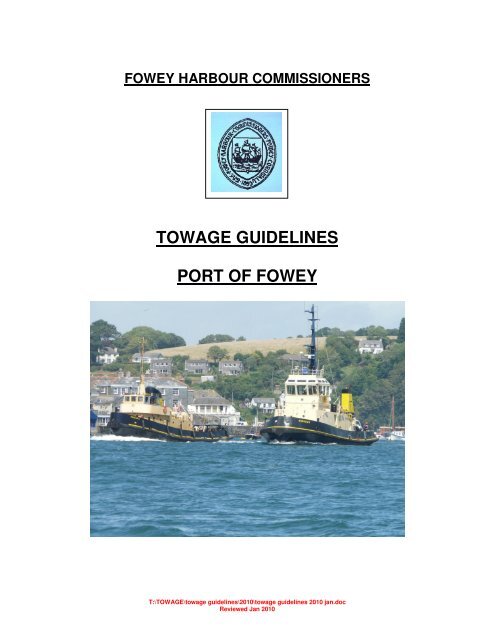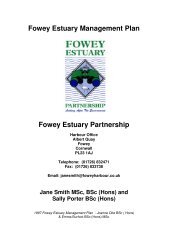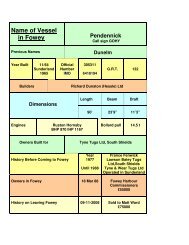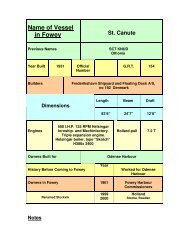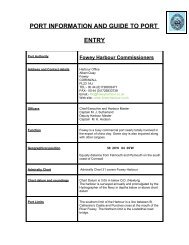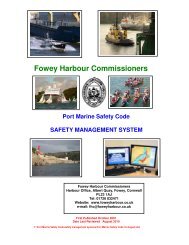TOWAGE GUIDELINES PORT OF FOWEY - Fowey Harbour
TOWAGE GUIDELINES PORT OF FOWEY - Fowey Harbour
TOWAGE GUIDELINES PORT OF FOWEY - Fowey Harbour
You also want an ePaper? Increase the reach of your titles
YUMPU automatically turns print PDFs into web optimized ePapers that Google loves.
<strong>FOWEY</strong> HARBOUR COMMISSIONERS<br />
<strong>TOWAGE</strong> <strong>GUIDELINES</strong><br />
<strong>PORT</strong> <strong>OF</strong> <strong>FOWEY</strong><br />
T:\<strong>TOWAGE</strong>\towage guidelines\2010\towage guidelines 2010 jan.doc<br />
Reviewed Jan 2010
Port of <strong>Fowey</strong><br />
Towage Guidelines<br />
T:\<strong>TOWAGE</strong>\towage guidelines\2010\towage guidelines 2010 jan.doc<br />
Reviewed Jan 2010
Towage Guidelines<br />
To ensure that towage is carried out to an agreed standard, the following<br />
guidelines have been produced by <strong>Fowey</strong> <strong>Harbour</strong> Commissioners in<br />
consultation with <strong>Fowey</strong> Pilots Association, Tug Masters, Ships Agents and<br />
Imerys Ports. These are produced with safety in mind.<br />
They are published for users’ guidance, supporting the port operations<br />
manual and <strong>Harbour</strong> Masters Directions and Notices.<br />
The Guidelines provide a safe working framework for the movement of larger<br />
vessels and disabled vessels using the port, or vessels as directed by the<br />
<strong>Harbour</strong> Master.<br />
Because of length restrictions and on occasions because of draft or lack of<br />
manoeuvrability, vessels will be directed to take tugs following risk<br />
assessments.<br />
These guidelines are based on using the following towage assets<br />
Morgawr 23.5 tonne B.P<br />
Tregeagle 15 tonne B.P<br />
Penleath 4 tonne B.P<br />
“Morgawr” is a Voith tractor with full Lloyds certification for coastal towage and<br />
maximum towage capabilities. The remaining assets are all conventional<br />
drive and steering and are best suited for straight tows and passive escort.<br />
These vessels may be employed for moves dependant on type, tug<br />
availability and duty required.<br />
<strong>Fowey</strong> is a narrow deep water port with 5 commercial berths. Modern vessels<br />
up to 95m LOA may turn around in Mixtow Reach if weather, tidal and port<br />
conditions permit. Due to the width in the river off the jetties and in particular<br />
in this location, there is insufficient “turning room” for vessels in excess of this<br />
size to turn unassisted. They are therefore turned in the lower harbour and<br />
towed stern first to their berths.<br />
Once inside the harbour, sheltered conditions prevail with the wind being<br />
funnelled north/south due to the high land immediately adjacent to the<br />
harbour. Strong tidal flows, especially on ebb tide and after heavy rain can be<br />
experienced.<br />
Vessels with bow and stern thrusters in good working order, together with<br />
high lift schilling type rudders may be given exemptions from the use of some<br />
tug numbers set out in the guidelines. Weather conditions and other vessels<br />
in port may also affect the application of the guidelines. Tug support may be<br />
directed when the use of the supporting tug is at the Masters/Pilots discretion.<br />
T:\<strong>TOWAGE</strong>\towage guidelines\2010\towage guidelines 2010 jan.doc<br />
Reviewed Jan 2010
Due to the fast flowing nature of the river <strong>Fowey</strong>, which may reach speeds in<br />
excess of 1.5 kts on a spring ebb and the effects of fresh water, towage<br />
operations are necessarily carried out at slack water periods, bearing in mind<br />
draft requirements and depths of 6.5m below chart data in the harbour mouth.<br />
Within the guidelines, various factors may be considered as to how tugs are<br />
used and how many and even if a movement should take place. These<br />
factors include;<br />
Length and draft of vessel Windage<br />
State of vessel/equipment State of tide<br />
Vessel type Weather<br />
Manoeuvring room available Berth required<br />
Ships crew experience<br />
Length & draft of vessel<br />
Over 92m, no bow thrust, vessels on 5/6 jetties etc. tug to swing.<br />
Over 95m Mixtow reach clear no V/L No 5/6 exemption considered.<br />
Over 7.5m draft 1 tug min H W move.<br />
Over 102m bow thrust, 2 tugs in 1 tug out.<br />
Over 105m 2 tugs each way.<br />
Depending on the state of the harbour with respect to vessels in port, berths<br />
used, state of tide and weather. Exemptions from towage requirements are<br />
given by the <strong>Harbour</strong> Master against risk assessments and advice to do so by<br />
the Pilot.<br />
Manoeuvring room Clear berths at Nos. 4, 5 & 6 giving more<br />
manoeuvring room may mean 1 tug use instead of<br />
2.<br />
Swing ground congestion may require 2 tugs.<br />
Windage Ships with large accommodation/cranes may<br />
require 2 tugs or 1 if under 92m.<br />
State of Tide Movements should be at slack water as a<br />
guideline 1-1 ¼ hrs. spring tide and either side HW<br />
or LW 2-2 ¼ hrs. neap tides.<br />
Ships Gear Without bow thrusters/dead ship/no anchors may<br />
require tug usage. Ships lines good condition.<br />
Berth Allocation Vessel going to and from No. 4 Jetty may be<br />
exempt tug and reduced use other movements.<br />
One in may be exempt use on departure from this<br />
berth.<br />
T:\<strong>TOWAGE</strong>\towage guidelines\2010\towage guidelines 2010 jan.doc<br />
Reviewed Jan 2010
Ships Crew/Experience <strong>Fowey</strong> handles regular callers familiar with port<br />
operations which may mean less tug use may be<br />
considered.<br />
Special Circumstances Where the vessel has defects or there are special<br />
circumstances that may effect the safe berthing,<br />
unberthing and navigation of the vessel, special<br />
category arrangements may be brought in. These<br />
will be decided by the <strong>Harbour</strong> Master after<br />
consultation with Pilots, Ships Master, Agents and<br />
Berth Operators .<br />
Limited Authorisation / PEC Holders<br />
No ships using limited authorisation (PEC) Pilotage will be allowed to operate<br />
with tugs. Tugs requiring tugs services to berth on depart from the port will be<br />
required to use authorised pilots<br />
Guidelines to Minimum Tug Requirements<br />
Tug Masters and tug crews are very experienced and have undergone<br />
considerable training. A three crew roster covers a 24 hour/seven day cover<br />
operation. Crews interchange and are experienced on all vessels.<br />
Pilots and Tug Masters carry out frequent accompanied movements and a<br />
close liaison and planning is carried out to ensure all operations are<br />
understood.<br />
All towage operations are detailed on the passage plan, discussed and<br />
agreed with Masters before each operation.<br />
Escorting vessels – as part of the towage operation, tugs may be used as in<br />
an escort mode. This will normally be in a passive role and may take two<br />
forms.<br />
On Knock Out – after an active tow, tugs will escort the vessel to the harbour<br />
mouth or to the berth. Mechanical failure can occur in the early stages of<br />
ships engines manoeuvring or at critical stages adjacent to berths.<br />
Manoeuvring with small under-keel clearances may require tug assistance.<br />
As Attendance Escort – when vessels, which are highly manoeuvrable but<br />
over tug size are escorted through the harbour or confined areas of the<br />
harbour. This operation will be agreed with Master of ship and noted in the<br />
tow log of the tug.<br />
Towing in Fog/ restricted visibility – whilst tugs are equipped with radar,<br />
keeping a radar watch by the Master whilst towing may be impractical and<br />
unsafe. Should visibility be severely restricted by fog etc, towage operations<br />
will be suspended until conditions improve. The <strong>Harbour</strong> Master will give<br />
directions in consultation with the Pilots and Tug Master.<br />
T:\<strong>TOWAGE</strong>\towage guidelines\2010\towage guidelines 2010 jan.doc<br />
Reviewed Jan 2010
In the event that visibility reduces whilst a tow is under way, guidelines exist<br />
within the Port Operations Manual to ensure the safety of the vessel and tugs.<br />
This includes holding the vessel in safe positions anchorages until visibility<br />
improves.<br />
Towage equipment – the “Morgawr” will either tow on tugs towing wire/<br />
pennant or ships ropes. For other towage units the normal practice is to tow<br />
on suitable ships ropes, the eye passed to the tug and rope made fast on<br />
bollard on the deck of the ship. This may include two ropes deployed together<br />
or from quarter/shoulder leads if there is no centre lead.<br />
In some cases tugs will pass special light-weight modern tow ropes,<br />
particularly when there is a need for bridal tows.<br />
Ships Crew/Experience – <strong>Fowey</strong> handles regular callers familiar with port<br />
operations which may mean reduced tug usage may be considered.<br />
Towage Training – as part of routine training, Tug Masters and Pilots<br />
regularly accompany the other and discuss matters regarding towage.<br />
From January 2008, due to a reduction in the tonnage handled in tug size<br />
vessels together with the normal practice not to charter very large vessels,<br />
towage coverage in the port will be covered by one tug. When two tugs are<br />
available, two tug operations may be provided for safety reasons.<br />
Out of Port Towage - “Morgawr” provides towage outside of the Port of<br />
<strong>Fowey</strong>. Separate guidelines are drawn up for these operations.<br />
T:\<strong>TOWAGE</strong>\towage guidelines\2010\towage guidelines 2010 jan.doc<br />
Reviewed Jan 2010
Assisting Falmouth Towage<br />
Towage services in Cattewater<br />
Taking a ship to the harbour Mouth<br />
T:\<strong>TOWAGE</strong>\towage guidelines\2010\towage guidelines 2010 jan.doc<br />
Reviewed Jan 2010


